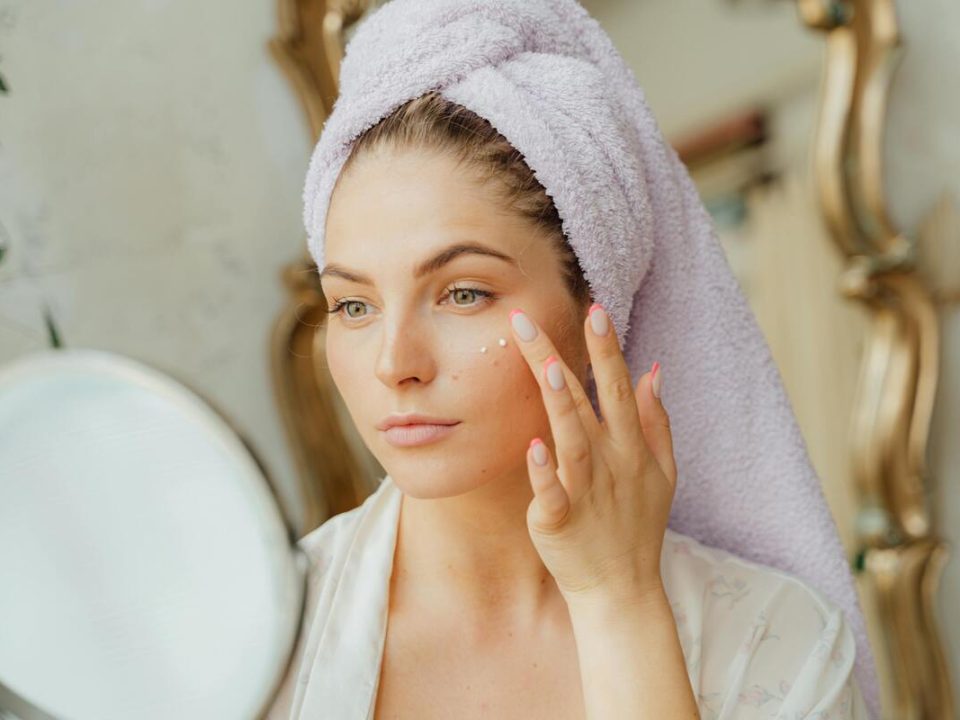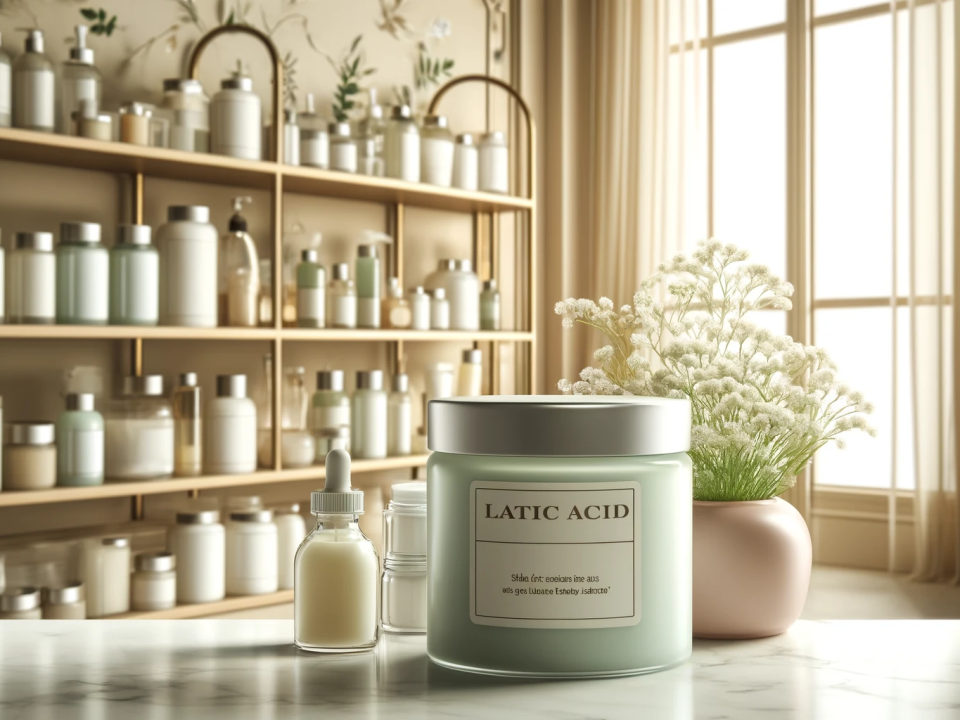
Exploring Lactic Acid’s Role in Skin Care: What You Need to Know
May 9, 2024
When And How Often Can You Use Lactic Acid For Your Skin?
May 9, 2024Lactic acid, a type of alpha hydroxy acid (AHA), offers several advantages for the skin. It helps by removing dead skin cells, brightening dark spots, and reducing the appearance of fine lines and wrinkles. This makes it suitable for all skin types, even those with sensitive skin.
You can find lactic acid in many skincare products available at stores and used in professional settings. It’s a common ingredient in topical products and is also used to treat conditions like eczema, psoriasis, and rosacea.
Benefits of Frequent Lactic Acid Exfoliation Usage
What Is Lactic Acid?
Lactic acid is a type of alpha hydroxy acid (AHA), which is found in sour milk, fruits, and vegetables. It has a special molecular structure that helps to achieve glowing skin. As an alpha hydroxy acid, it’s part of a group known as exfoliants. These substances are celebrated for their gentle ability to remove dead skin cells, clear clogged pores, and promote skin renewal.
Benefits of Lactic Acid for Your Skin
Lactic Acid not only brighten and exfoliate the skin but also reduce the appearance of sun damage and pigmentation. It’s generally gentler than other exfoliating acids, like glycolic acid, making it a suitable choice for those with dry or sensitive skin or anyone trying chemical exfoliants for the first time.This is amazing for your skin because it helps to peel away old, dead skin cells. It gets into the top layer of your skin and loosens the glue that holds these dead cells together. This not only brings out new, healthy skin but also boosts the creation of collagen, making your skin look fresher and younger.
The Beauty of Lactic Acid for Glowing Skin
Discover the amazing benefits of lactic acid, a standout ingredient that does more than just the basics. Let’s dive into the fantastic advantages it offers for your skin:
Gentle Exfoliation
Is a true hero when it comes to exfoliating. It helps brighten your skin, reduce dark spots, smooth out its texture, and clear out pores, all while being gentle enough for those with dry or sensitive skin.
Superb Hydration
Unlike usual exfoliants, lactic acid also hydrates. It draws moisture into the skin, helping to hydrate and plump it up. This unique ability makes it perfect for combatting dullness and dry skin.
Fights Germs
With its antimicrobial powers, lactic acid helps fight off harmful bacteria, promoting a healthier skin environment. This action reduces inflammation and strengthens the skin’s natural defenses.
Brightens Skin
Known for its skin-brightening effects, lactic acid removes dead skin cells, uncovering the fresher, brighter skin beneath.
Enhances Skin Texture
Regular use of lactic acid can smooth out uneven skin textures, making it an effective choice for managing rough patches and uneven skin tones.
Reduces Acne
By preventing pore clogging, lactic acid is also helpful for those prone to acne, keeping breakouts at bay.
With these benefits, lactic acid is an essential ingredient for anyone looking to improve their skin’s health and appearance.
How to Effectively Add Lactic Acid to Your Skincare Routine
Adding these to your skincare routine can be incredibly beneficial if done correctly, ensuring you reap all the benefits without overwhelming your skin.
Follow this straightforward guide to integrate this key ingredient into your skincare practice:
Start Slowly
If you’re new to Lactic acid, it’s wise to start with a gentle approach. Use products with lower concentrations, around 5-10%, which lets your skin gradually get used to this effective exfoliant. This slow introduction helps reduce the risk of irritation and helps you assess how well your skin tolerates it.
Pick the Suitable Product
It comes in a variety of forms such as cleansers, toners, serums, and masks. Choose a format that you prefer and that blends smoothly into your current skincare routine.
Select a Mild Exfoliator
Consider using a gentle cleanser. For example, our AHA FOAMING Facial Cleanser with 10% Glycolic Acid- 7.5 oz Face Wash for Acne, Oily Skin.
Glycolic Acid Facial Cleanser removes dirt, excess oil and exfoliates without irritating, Helps rid your skin of dullness and fine lines and leaves your face looking vibrant and radiant. It’s recommended to use this cleanser twice a week, followed by sunscreen.
Apply a Soothing Moisturizer
A moisturizer is key to sealing in hydration and balancing out any dryness from exfoliation. Lactic acid’s dual role as both an exfoliant and a humectant provides dual benefits, making it a unique and effective ingredient.
Watch Your Skin’s Reaction
Keep an eye on how your skin adjusts to Lactic acid. If you experience any irritation, redness, or significant dryness, you might need to use it less frequently or switch to a product with a lower concentration. Since everyone’s skin is different, tailor your approach to suit your specific skin needs.
The Role of Lactic Acid in Enhancing Skin Brightness
Lactic acid is a key ingredient in skincare, offering multiple benefits. It gently removes dead skin cells, making it a mild exfoliator. By controlling the production of melanin, it helps in achieving a more uniform skin color and diminishes discoloration.
It also acts as a moisturizer, helping to keep the skin hydrated and making it look full and refreshed. Additionally, its ability to fight off harmful microorganisms helps maintain a healthy skin environment. With these properties, lactic acid not only makes the skin look brighter but also strengthens it for lasting radiance.
Potential Side Effects of Lactic Acid
Is known to be a milder choice compared to other AHAs for skin treatment, but it still packs a potent punch. Here are some side effects you might encounter.
Increased Sun Sensitivity
Before you start applying lactic acid, it’s crucial to understand that it increases your skin’s vulnerability to the sun. As it removes dead skin cells, your skin becomes more prone to damage from the sun’s ultraviolet rays.
Research indicates that this heightened sun sensitivity could persist up to four weeks after you stop using lactic acid treatments, or possibly even longer.
To shield your skin from sunburn and other sun damage, use sunscreen with at least SPF 30 every day, even when it’s cloudy. Failing to protect your skin could negate the positive effects of lactic acid, such as reducing spots and softening lines.
Potential Skin Irritation
This may also lead to skin irritation. Watch out for symptoms like:
- Redness
- Burning sensation
- Peeling
- Dryness
- Itchy skin
- Swelling
Initial mild redness, burning, and itching are common when you start using lactic acid but usually subside within an hour. This is typically no cause for concern.
However, if you experience moderate to severe redness, burning, itching, swelling, or a rash that doesn’t go away, remove the product immediately and stop its use. It’s important to consult your healthcare provider for further guidance.
When Not to Use Lactic Acid
While lactic acid is the least harsh among alpha hydroxy acids, it’s not suitable for everyone.
If you have susceptible skin, begin with a product that contains a lower concentration of lactic acid (e.g., 5%) to see how your skin reacts. Discontinue use if irritation occurs.
Avoid mixing with topical retinoids like Retin-A or Refissa, as these are already exfoliating your skin. Combining them can overly sensitize your skin.
Usage frequency varies; some may tolerate daily use, while others with more sensitive skin might need to use it less often. Always consult with your healthcare provider to determine the right frequency for your skincare routine.
How to Apply Lactic Acid: A Nighttime Routine
When to Use It
Apply lactic acid products exclusively at night. Along with other AHAs, increases your skin’s sensitivity to UV rays. Integrate it into your nighttime skincare routine and make sure to use sunscreen in the morning to shield your fresh, exfoliated skin from sun damage.
Getting Started
It’s common to experience mild stinging and redness initially. Your skin will adjust over time. Before using it on your entire face, do a patch test. Apply a small amount on a part of your forehead in the evening. This area is ideal because the skin is thicker. When after 24 hours, the irritation is mild or non-existent, you can apply a thin layer over your face (avoiding the eyes) once or twice a week.
If severe irritation occurs, try a product with a lower acid concentration. If lactic acid doesn’t suit you, avoid switching to glycolic acid, as it might be harsher. Start with a low-concentration lactic acid product (below 10%) and gradually build up as your skin gets accustomed to it.
Application Tips
For best results, apply it evenly across your entire face, avoiding the eyes, lips, and mouth area to ensure uniform exfoliation.
Amount Matters
Use just a pea-sized amount for your entire face. Using more can lead to excessive irritation.
Frequency of Use
Exfoliate with lactic acid only once or twice a week. Exfoliating more frequently can cause significant irritation, redness, breakouts, and dryness, which may accelerate skin aging.
Avoid Physical Scrubbing
Is a chemical exfoliant and loosens dead skin cells without the need for physical scrubbing. Let the product work on its own.
Post-Application Care
Always follow up with a moisturizer to keep your skin hydrated and minimize potential irritation and redness. Apply moisturizer both in the morning and at night.
Sun Protection
Sunscreen is crucial. Since lactic acid exposes newer, more vulnerable skin, it’s vital to protect it with sunscreen every day to prevent sun damage, as recommended by the FDA.
By sticking to these guidelines, you’ll ensure safe and effective use of lactic acid in your skincare regimen.
Conclusion
Lactic acid is a type of alpha hydroxy acid that’s great for your skin. It helps to get rid of dead skin cells, lighten dark spots, and smooth out small wrinkles.
You can find it in various strengths in over-the-counter products like cleansers, lotions, and masks you can use at home. For a more intense treatment, you might consider a professional acid peel at a spa or dermatologist’s office.
If you’re just starting out, especially with sensitive skin, try a product with a lower strength. And don’t forget to apply sunscreen! This can make your skin more sensitive to the sun, increasing your risk of sunburn.









